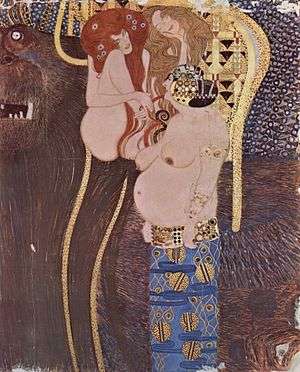Beethoven Frieze
|
Part of the frieze | |
| Artist | Gustav Klimt |
|---|---|
| Year | 1901 |
| Location | Secession Building, Vienna, Austria |
The Beethoven Frieze is a painting by Gustav Klimt on display in the Secession Building, Vienna, Austria.
Description
In 1901, Klimt painted the Beethoven Frieze for the 14th Vienna Secessionist exhibition in celebration of the composer, and featured a monumental polychrome sculpture by Max Klinger. Meant for the exhibition only, the frieze was painted directly on the walls with light materials. After the exhibition the painting was preserved, although it did not go on display again until 1986.[1] The Beethoven Frieze is on permanent display in the Vienna Secession Building in a specially built, climate controlled basement room.[2]
The frieze is large, standing at 7 feet high with a width of 112 feet. The entire work weighs four tons.[3]
The frieze illustrates human desire for happiness in a suffering and tempestuous world in which one contends not only with external evil forces but also with internal weaknesses. The viewer follows this journey of discovery in a stunning visual and linear fashion. It begins gently with the floating female Genii searching the Earth but soon follows the dark, sinister-looking storm-wind giant, Typhoeus, his three Gorgon daughters and images representing sickness, madness, death, lust and wantonness above and to the right. Thence appears the knight in shining armour who offers hope due to his own ambition and sympathy for the pleading, suffering humans. The journey ends in the discovery of joy by means of the arts and contentment is represented in the close embrace of a kiss. Thus, the frieze expounds psychological human yearning, ultimately satisfied through individual and communal searching and the beauty of the arts coupled with love and companionship.
Depiction on coin

Because of the frieze's fame and popularity, it was made the main motif of a collectors' coin: the Austrian 100 euro Secession Coin, minted on November 10, 2004. The reverse side features a small portion of the frieze. The extract from the painting features three figures: a knight in armor representing “Armored Strength”, one woman in the background symbolizing “Ambition” holding up a wreath of victory and a second woman representing “Sympathy” with lowered head and clasped hands.
See also
Notes
- ↑ "Beethoven Frieze". klimt.com. Retrieved January 22, 2015.
- ↑ "The Beethoven Frieze". Secession.at. Vienna Secession. Archived from the original on December 24, 2014. Retrieved January 22, 2015.
- ↑ Cohen, Patricia (October 15, 2013). "Heirs Press Austria to Return Looted Klimt Frieze". New York Times. Retrieved January 22, 2015.
External links
| Wikimedia Commons has media related to Beethovenfries. |
- Beethoven Frieze in the online catalog of the Vienna Secession (in German)
- Beethoven Frieze, video discussion about the painting from Smarthistory at Khan Academy
